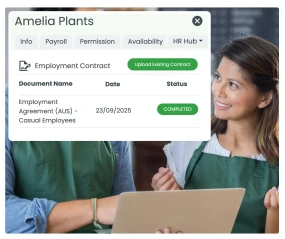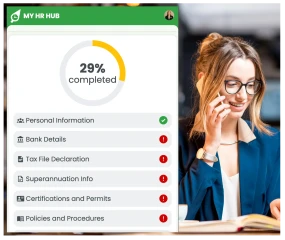Featured summary: Paper vs Digital at a glance
Digital wins on speed, accuracy and visibility. Paper contracts rely on printing, scanning and manual filing. Digital employment contracts deliver same‑day turnaround, audit trails and secure storage — all from one platform. See how it works with RosterElf’s digital employment contracts.
Introduction — The old way vs the new way
Scenario: You’ve just hired a new supervisor. On paper, the contract journey involves emailing a PDF, waiting for a print‑sign‑scan, chasing missing initials and filing the final copy somewhere on a shared drive. Digitally, you choose a template, send it in minutes, track status in real time and receive a defensible, signed PDF with an audit log — no printer required.
Round 1: Speed and efficiency
Paper
- Print, post or scan; wait days
- Manual follow-ups by email
- Version confusion
Digital
- Instant delivery; mobile e-sign on any device
- Automatic reminders and real-time status
- Single source of truth with audit trail
Faster sign-offs mean faster starts. Send, sign and store in one flow using digital employment contracts.
Round 2: Compliance and accuracy
Paper processes increase the risk of outdated clauses, missed initials and incomplete award details. Digital platforms use pre‑vetted templates, mandatory fields and standard approvals so you capture the right information every time. That supports obligations under the Fair Work Act/NES and strengthens audit readiness.
Build a defensible workflow with templates, audit logs and role‑based access in RosterElf’s digital employment contracts.
Round 3: Accessibility and storage
Paper files can be lost or damaged and are slow to find. Digital contracts live in a secure, searchable repository with encryption in transit and at rest. Retrieval takes seconds, sharing is controlled and backups are automated — ideal for audits or responding to employee requests.
Round 4: Cost and environmental impact
Paper introduces ongoing costs (printing, postage, off‑site storage) and environmental waste. Digital involves a software subscription, but dramatically reduces consumables and storage space while aligning with sustainability goals. Over time, the time savings alone often offset the licence cost.
Round 5: Employee experience
Today’s teams expect modern, mobile‑friendly onboarding. Paper feels slow and old‑fashioned. Digital lets new hires review and sign on their phone, see status, and access the final contract whenever they need it — a small touch that reflects well on your brand.
Case in point — Australian context
Across Australia, SMEs are rapidly adopting digital HR practices. E‑signatures are generally recognised under national and state electronic transactions laws when identity, intent and consent are demonstrated, and digital record‑keeping makes audits simpler. In practice, many businesses now treat digital contracts as their default — especially when hiring across multiple sites.
Conclusion — The verdict
On speed, compliance, access, cost and employee experience, digital wins decisively. Retire the printer and move to a faster, smarter contract workflow. Start by piloting with your next few hires and iterate from there — or jump straight in with RosterElf’s digital employment contracts to see the end‑to‑end flow in action.



